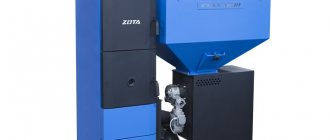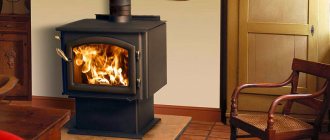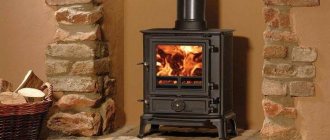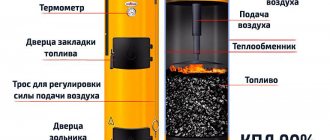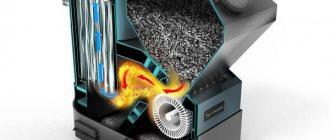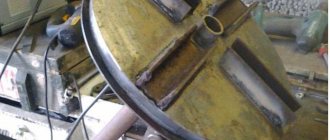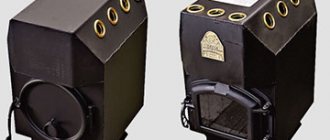Domestic brick stoves for coal remain worthy competitors to solid fuel boilers in a situation where in winter it is necessary to heat a small and medium-sized home, and main gas is not supplied. If in some respects coal stoves are inferior to steel and cast iron heat generators, then in other respects they have no equal. Therefore, the demand for the construction of brick kilns remains consistently high.
Using coal instead of firewood is an inexpensive and efficient option for heating your home.
Principle of operation
The operating principle of a coal stove is not much different from a wood stove. This is a very common misconception. Coal and wood heating stoves differ radically. And here's what:
- For coal to burn, air must come from below.
- Coal requires preheating before being sent to the firebox. Raw coal simply won't burn.
- The chimney should allow air to flow faster than a wood stove. With this design, there is no damper at all. The air supply is regulated from below, through the blower.
The combustion process of coal takes much longer. Coal does not burn quickly like firewood, but smolders over a long period of time. The combustion temperature is higher, which places special demands on the materials for the manufacture of the stove. We'll talk about this later.
Speaking about the process of burning coal, it is worth paying attention to one feature. If firewood during the pyrolysis process easily breaks down into coke and gases, which have a high temperature and heat transfer, then coal burns differently. On the surface it will have the highest temperature, and the temperature of the exiting gases will be much lower.
Production of charcoal in a charcoal kiln
In addition to waste wood of various species, knots, sawdust, and hemp are suitable for the production of charcoal. If the area is swampy, peat is used for these purposes. The process of burning wood goes through mandatory 3 stages:
- Drying.
- Thermal decomposition.
- Cooling.
The first step requires heating the chamber in which the raw material is placed to a temperature of 280 0C. Only after this does an exothermic reaction begin with the release of thermal energy and the process of “cooking” coal begins.
The finished product requires cooling to the point where spontaneous combustion becomes impossible. Usually this indicator is kept at 40°C. Even after cooling for about another day, the mixture of released gas will contain a large percentage of water. After complete drying, you can use the material for its intended purpose.
Device
A DIY coal stove includes the following elements:
- blower;
- firebox;
- chamber for drying fuel;
- chimney.
The design of the firebox and chimney differs from analogs that burn wood. The firebox has two compartments. In one compartment, firewood is lit, in the other, coal is dried. Once the temperature is sufficient, the coal also begins to burn. This is due to the fact that coal has a fairly high combustion temperature and it is simply impossible to light the stove using the standard method.
A combination firebox is often used, which can operate on both wood and coal. This option is the most rational for a coal stove for heating a home.
Main types of homemade stove designs
Here are the main types of structures:
- non-removable;
- partially collapsible;
- completely collapsible.
The advantages of a non-separable design are maximum rigidity and strength, the main disadvantage is the large size. A partially collapsible oven consists of several blocks, so its strength and rigidity directly depend on the same parameter of each block.
Based on the type of fuel combustion, these devices are divided into 3 main designs:
- traditional;
- with lower secondary air supply;
- with upper secondary air supply.
The first consists of walls and a bottom, so its design is the most primitive and easiest to manufacture. The second is noticeably more complicated, because it is formed from outer and inner buildings installed on a common bottom. Secondary air, which did not enter through the grate holes, freely passes between the outer and inner casings.
Kinds
Coal stoves for heating a home can be characterized by the following indicators:
- By appointment. A coal stove can be used not only for heating, but also perform additional functions. According to this parameter we can distinguish:
- Heating stoves. Coal is an efficient fuel. Such coal stoves, especially those made of brick, are much more powerful than their wood-burning counterparts. They are able to provide heat to the entire house, and not just 1-2 rooms. This oven is large in size and weight. In production, materials with increased strength characteristics and maximum heat resistance are used. Such a heater requires a reliable foundation on a perfectly level base.
- Stoves and fireplaces. A coal stove-fireplace can not only reliably protect a room from the cold, but also performs a decorative function. Such stoves must have an attractive appearance and often become a central design element. The main attention is paid to the correct selection of finishing materials. It must meet several parameters: be environmentally friendly, retain heat well, protect against injury, and have an attractive appearance. Most often, natural stone is used for finishing.
- Ovens with hob. They have an additional cooking surface that allows you to cook food. The container must be thick enough to withstand the high temperature. It is ideal to use cast iron. This cookware will never burn out and food cooked in it has a special taste. This material is also suitable for making a hob, but has a big drawback. Cast iron is very brittle and cracks easily. Therefore, you will have to be extremely careful when using it. Alloy steel is also used for the hob. This material is not afraid of temperature changes and is very durable. It is used more rationally.
- Stoves for household needs. We are talking about a furnace with a heat exchanger. This option will not only save you from the cold, but will also provide you with hot water, which can be used for household needs. You can install a heated floor system. This will allow the room to be heated more evenly.
- According to the type of material used. For a stove that runs on coal, you need to use a material with increased resistance to high temperatures. Experts recommend making a stove from the following materials:
- Brick is the most common material for making stoves. Its advantage lies in its high heat capacity - the material is able to accumulate heat and release it evenly over a long period of time. The disadvantages are also obvious: the large mass of the structure and the complexity of manufacturing. From the point of view of financial costs, it is the most economical option.
- Steel has become a frequently used material recently. The material is quite strong and durable. It is used for the manufacture of factory products. It is better to make a steel coal stove with your own hands. The labor intensity of the work is significantly lower than when making an analogue from brick. The room heats up faster, but there is a significant drawback. A steel stove, unlike a coal-fired brick stove, is not capable of retaining heat. As soon as the fuel runs out, it instantly cools down.
- Cast Iron - Cast iron occupies an intermediate position between steel and brick. The weight of such a furnace should be significantly greater than a steel one. It will heat up and cool down faster than brick. With careful use, this design will last for several decades. Making such a stove yourself is quite problematic. A factory analogue will not be cheap.
- Talkomagnesite. The material has excellent thermal conductivity - ten times higher than that of brick. And this despite the fact that its ability to store heat is only 44% worse. What does this mean in practice? Such a stove will heat up almost as quickly as a metal one, but will produce enough heat to avoid adding fuel during the night. This material is also not without its disadvantages. Such a heating stove will be heavier than a brick stove with the same dimensions and is not cheap.
- Combined. It is impossible to select the ideal material for a heating stove. As you can see above, each material has its pros and cons. What if we take their strengths and combine them with each other? The advantages of one material can successfully offset the weaknesses of another. This technique has been used for quite a long time. A cast iron boiler can be lined with soapstone (another name for the mineral is soapstone or stove stone) and a water heating circuit can be added.
- According to the method of fuel combustion. A distinction is made between stoves with a conventional firebox and devices with a long-term combustion function, which can operate up to 3 times longer on the same amount of fuel.
Properties of a natural fuel stove
Foundation for a brick kiln.
As already mentioned, the combustion temperature of coal is quite high. With sufficient air supply to the firebox, it reaches 1000-1100 °C, so not every material can withstand such conditions for a long time.
For comparison: dry wood under identical circumstances can produce no more than 700 °C in the firebox, and even then very rarely. In addition, coal fuel is much higher in calories than firewood.
That is, when burning 1 kg of anthracite, almost 2 times more thermal energy is generated than from the same amount of wood, as shown in the table:
| Type of fuel | Calorific value | |
| MJ/kg | kW/kg | |
| Wood with a moisture content of 25% | 10,1 | 2,8 |
| Stone coals | 21,5 | 5,9 |
| Brown coals | 15,5 | 4,3 |
Previously, in old houses, heating stoves or slabs were made only of solid red brick. When constantly burning high-calorie coals, the masonry gradually began to crumble due to exposure to high temperatures, so the owners lined the inside of the firebox with thick steel soles from railway tracks to protect the walls.
At the moment, the problem of burning coal is solved much easier - with the help of fireclay bricks. The design of the furnace provides for lining the fuel chamber with fireclay stone grade ША, ШБ or ШВ to a thickness of a quarter or half a brick. This material can easily maintain temperatures of 1400 °C and short-term temperatures of up to 1650 °C.
Tools for laying a stove.
There is another point: due to the higher calorie content than wood, a larger amount of heat is released, part of which goes with the combustion products into the chimney.
To avoid this, a more developed smoke circulation network is provided in the coal furnace, where flue gases have time to transfer heat to the brick walls, and not immediately fly out into the chimney.
Otherwise, this is an ordinary brick stove with all the advantages and disadvantages.
Advantages and disadvantages
The following advantages of coal stoves can be highlighted:
- High power - achieved due to the higher temperature of fuel combustion.
- High efficiency - up to 60% with a conventional firebox (in a brick kiln) and up to 90% in a long-term combustion kiln made of brick.
Disadvantages are also present, but they can be effectively dealt with:
- Coal stains everything around . The problem is solved by installing a firebox in a separate room.
- Formation of dust, soot and soot. You will have to clean the chimney regularly (at least twice a year). Combustion products from the ash pit must be removed before each new firebox. All joints must be hermetically sealed with fireclay clay.
- Coal is demanding on storage conditions . This should be a separate dry room, protected from wind and precipitation. There is no point in storing coal for more than a season. It cakes and you end up with lumps, which are not very pleasant to break out every time.
- High price. This issue varies greatly by region. In some places, coal is rare and its use is not economically feasible. In other places it is the main type of fuel. Compared to wood, the higher price is offset by longer combustion time and greater heat output (fuel savings).
How to build a stove?
First you need to understand what requirements are put forward for a heating stove for coal:
- the heater must warm up evenly and quickly, intensively transferring heat to the air in the rooms;
- the outer walls of the brickwork facing the rooms can warm up to a maximum of 90 °C;
- fuel combustion must be efficient;
- the stove should be located in the house in such a way that its walls heat several rooms;
- when constructing the body of the stove and chimney, it is important to comply with all fire safety rules;
- It is not allowed to use flammable materials during construction;
- the masonry must be smooth, without cracking;
- The heater should be finished in accordance with the interior of the home.
When the requirements are known and worked out in relation to your home, you should select a stove design that is suitable in size and lay a solid foundation for it.
Laying the foundation
Layout diagram of a corner stove.
A coal stove is a massive and quite heavy structure, and therefore the foundation for it must be made reliable. Its dimensions in plan are taken to be 5 cm larger in each direction from the dimensions of the future structure.
An important condition: the foundation of a brick heating or cooking device should not be connected to the base of the building itself, but should be at least 10 cm away from it.
Work on laying the foundation is carried out in the following sequence:
- Dig a hole, the depth of which depends on the location of non-subsidence layers of soil (clay). Compact the bottom of the pit using a hand tamper.
- Pour a layer of crushed stone 10-15 cm thick and compact it too.
- Next, you can fill the pit with rubble stone and water it with liquid mortar, or pour a reinforced concrete slab. The height of the base is made level with the subfloor.
- For waterproofing, 2 sheets of roofing material must be laid on the upper part of the foundation after the concrete has hardened, and for fire insulation - basalt cardboard and roofing steel.
After laying the foundation, you can begin building the stove according to the procedures.
How to choose for a home and selection criteria?
To choose the right oven you need to consider the following:
- The design is factory or made by hand. Below we provide detailed instructions for both options.
- Determined by the type of furnace (see the corresponding section).
- Select the necessary parameters. Let's dwell on this point in more detail. In order for the stove to live up to your expectations, you need to consider the following:
- Choose the right power. With factory appliances, everything is simple - manufacturers indicate in the passport the power and cubic capacity for which the stove is designed. You should try to ensure that the volume that needs to be heated is somewhere in the middle of the specified range. This will ensure the necessary reserve in case of possible heat loss. With a homemade stove, not everything is so simple. You will have to perform the calculation yourself, using the formula:
P = (M-Bridge)*Sp/T/1000, where
P – required power, kW
M - weight of fuel used, kg
BRIDGE - mass of the remainder of the burned fuel (i.e., what remains after the active combustion phase), kg
Cp - thermal conductivity of coal, J/kg
T is the coal burning time. M is determined by the formula: M=a*b*c*Pl*Kz, where
M - weight of fuel used, kg
a, b, c - overall dimensions of the firebox from the inside, m
Pl - coal density, kg/m3
Кз - furnace fill factor (usually taken 0.6-0.7). By substituting the initial data, it is easy to determine the power that the stove will produce. To determine the usable power, multiply it by the efficiency of the furnace.
Now let's determine the required power. For 1 m2 of area you need 0.1 kW of heat. These figures do not take into account possible heat loss, which is different in each room. Therefore, it is recommended to take power with a margin of 10-15%.
- Material of manufacture.
- Volume of loading and automation. Coal loading in modern boilers can be automated to such an extent that fuel will have to be added every few weeks. The rest of the time the oven will operate in autonomous mode.
About the temperature in the garage
In such a room it is not easy to equip a traditional heating system, and all this will be quite expensive. On the other hand, the optimal air temperature must be maintained in the garage, because it is not recommended to store the car at temperatures less than +5 degrees , while a minimum of +18 degrees .
Typically, compact, economical stoves with fairly high efficiency and good heating of the room are used to heat garages. It is also important that the stove warms up the garage quickly and is safe at the same time. It’s a big plus if the fuel can be various types of waste – wood, for example, or recycled motor oil. This will make heating your garage even cheaper.
Note! Portable electric heaters for garages are almost never used because they are ineffective. They are also unsafe and should not be left unattended. And no one wants to spend the night in the garage to look after all this.
Garages are rarely well insulated using high-quality thermal insulation materials, and therefore heat loss in such rooms is usually high. In addition, to heat a small area, sometimes much more energy is needed than to heat a house. On average, a heating device with a power of 2.5 kW is enough to heat a garage with a standard area. To maintain a constant temperature of about +16 degrees, you will need a 2 kW oven. Quite often, owners, trying to save money, do not heat the entire garage, but only the area where they work.
On a note! If you properly insulate gates and walls, as well as seal all cracks, you can reduce heat loss and thus save money, since it will be easier to maintain the required temperature.
Best models
Let's look at the best factory-made models, and then move on to making a coal stove with your own hands. These models are suitable even for a large country cottage. You can buy them on the manufacturer’s website by submitting an online application.
| Name and price (RUB) | Characteristics | ||||
| Room area m2 | power, kWt | Dimensions, mm Chimney, mm | Weight, kg | ||
| Zota stakhanov 100, from 370000 | 1000 | 100 | 900x1608x1796, 800 | 880 | |
| Teplov T-100, from 185000 | 1000 | 100 | 1770x810x810, 250 | 900 | |
| Vulkan EKO-100, from 330000 | 1500 | 100 | 1770x810x810, 250 | 900 | |
| “Bourgeois-K” T-100A-2K, from 272000 | 1000 | 100 | 780x1420x1890, 250 | 900 | |
| Ferroli Forest 100, from 1200000 | 1000 | 115 | 2898x4533x2700, 200 | 1230 | |
Do-it-yourself coal stove for a summer residence
The cheapest way to make a brick heating stove using coal with your own hands.
Materials
We will need:
- brick;
- ready-made mortar mixture for laying stoves;
- cast iron grate;
- cast iron hob;
- metal sheet b=4mm - 600x1200 mm - 0.72 m2;
- electrodes for welding - 1 pack.
Tools
- trowel;
- trowels;
- hammers;
- drill;
- other.
Scheme and order
Photo No. 1 General view
Photo No. 2 Ordering
Description of the masonry
- We lay a brick on top, without mortar (see photo No. 2, first row). We strictly control horizontality using a level.
- We install the door for the blower. We secure it with wire and wrap it with asbestos cord.
- We place grate bars directly above the ash pit.
- We continue laying according to the order (see photo No. 2)
- Installing the firebox door. We secure it with wire and bricks.
- The row at the top should overlap the combustion door and end 130 mm above it.
- We continue laying, moving the bricks back a little. Before this, we lay an asbestos cord on which we will install the hob.
- Let's start forming the chimney from the next row. The design provides for the installation of a mounted pipe made of tin or corrugated aluminum. The pipe should not be heavy. Otherwise, the center of gravity may shift.
- On the eleventh row we install a valve to regulate the air flow. Don’t forget to seal it with asbestos cord and cover it with clay.
- Next, we place a chimney pipe in the quadrangle, which we connect to the metal one. The pipe must stand strictly vertically and not lean to the side. For greater stability, it should be covered with three rows of bricks.
- We remove the knockout bricks that we placed on the 4th row and clean the chimney of debris.
- Now the coal stove for the home should be whitewashed. Any lime will do. Experts recommend adding blue and a little milk. This way the whitewash will not darken and fly off.
- We install a metal sheet in front of the firebox.
- Installing the plinth
Making a charcoal stove with your own hands is not easy. It is better to seek help from an experienced stove maker or be patient.
Recommendations for masonry
To lay a stove where you plan to burn coal, you will need 2 types of mortar - clay-sand and fireproof. With the help of the first, the body of the furnace is built from solid ceramic bricks, and the second is used for the internal masonry of fireclay stones. The thickness of the seams also differs: for ordinary masonry it is a maximum of 5 mm, for fireproof masonry - 3 mm.
To prepare both types of mortar, it is recommended to purchase ready-made construction mixtures that are commercially available. Only experienced stove makers can make a good solution from natural clay. You also need to prepare masonry and measuring tools, and then start building the stove:
- Before laying on the mortar, each row of bricks must be laid out dry to try on and adjust the stones to size.
- Before putting the brick in place, it must be dipped in a bucket of water.
- It is advisable to place the stones in one precise movement so that you have to tap less.
- Trim off the remaining mortar on the front side with a trowel, and wipe dry on the smoke exhaust side with a rag.
- Control each row horizontally and vertically.
- Leave a 5 cm wide gap between regular and fireclay masonry, which is then filled with basalt fiber.
- Install a cast iron stove with burners and doors using rolled metal support elements.
The stove solution does not harden, but dries, for which it needs to be given 2-3 days. Afterwards, all that remains is to lay out the chimney, observing the rules for passing through the floors and roof, and at the end make a test firebox. You can fill the stove with coal only after it has completely warmed up, making sure that there are no cracks or crevices.
